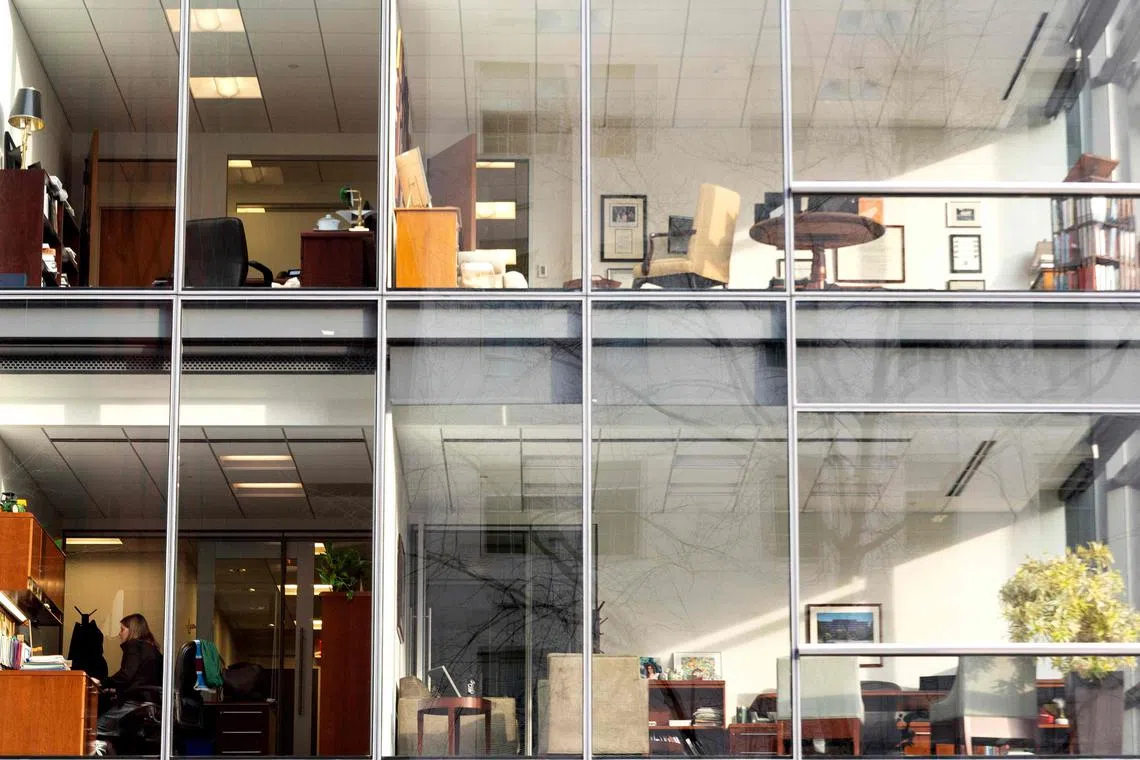More than a third of office desks globally sit empty all week long
Sign up now: Get ST's newsletters delivered to your inbox

A new report raises questions about how well workplaces are currently designed as companies struggle to get employees back into them.
PHOTO: AFP
Follow topic:
NEW YORK – Over a third of desks in offices around the globe are unoccupied all week, according to a new report, raising questions on how well workplaces are currently designed as firms struggle to get employees back into them.
The report, from Australian workplace sensor provider XY Sense, found that 36 per cent of so-called workpoints – cubicles and desks – are never occupied, “indicating a general oversupply”.
Of those that are used, 29 per cent were for three hours or less on a given day. Just 14 per cent were occupied for five or more hours, according to the study that tracked 24,855 unique work areas in nine places including the United States, Britain, Hong Kong and Singapore.
Among the spaces used the most are meeting rooms for two or three people, which are 90 per cent full on average. Overall, office utilisation is stuck at about 50 per cent of pre-pandemic levels.
The findings illustrate the challenges faced by organisations as they assess office-space needs.
Workers and managers both say they should be on site at least one-third of the time, according to research from Boston Consulting Group, but much of that in-person time is no longer spent tethered to a desk.
Spaces for small, private huddles, more open collaboration, and sound-proof enclosures for individual head-down work are all more relevant today compared with old-fashioned cubicles. Yet 80 per cent of total floor space is taken up by individual workstations, with 20 per cent left for collaboration, XY Sense found.
“It’s time to rethink the humble desk. They dominate space in our offices, they’re expensive, and we’re just not using them the way we were pre-pandemic,” said Mr Alex Birch, co-founder and chief executive of XY Sense.
“Companies just need less of them now that people do the majority of their focus work at home. Companies should either redeploy that desk space for better workplace experiences or pocket the savings, but they can’t ignore the waste that’s going on.”
Other data supports the shift away from desks. Research from office-furniture maker Haworth found that 85 per cent of employees had their own individual workstations before 2020, yet less than half do now.
Following years when firms simply crammed as many employees as they could into static cubicle farms, or long rows of workstations, some see the changes wrought by remote work as long overdue.
“For far too long we designed offices as if we’re potted plants,” said Ms Kay Sargent, director of workplace practice at architecture and design firm HOK.
“Are you really inviting people back to the office to have them sit at a desk all day? Or do you want to encourage them to connect, mentor and innovate?”
The dearth of desk use could also prompt employers to rethink their real estate needs. Over nine out of 10 big organisations reported low office utilisation rates in a survey by CBRE, and over half expect to reduce their real estate footprints in the next three years.
According to XY Sense’s data, office utilisation did not change much between the first and second quarters of 2023. But about one million US desk workers face mandates to return to offices more often by the end of the year, according to brokerage JLL.
Ms Domino Risch, a principal and co-leader of the workplace and commercial sector at architecture firm Hassell, said in the report: “We need to address the fact that we’ve accidentally created call centre environments with the acres of large open workstations that are a feature of most offices these days.
“The repetitive banks of open-plan workstations that typical knowledge-based organisations have just aren’t fit for purpose any more.” BLOOMBERG

